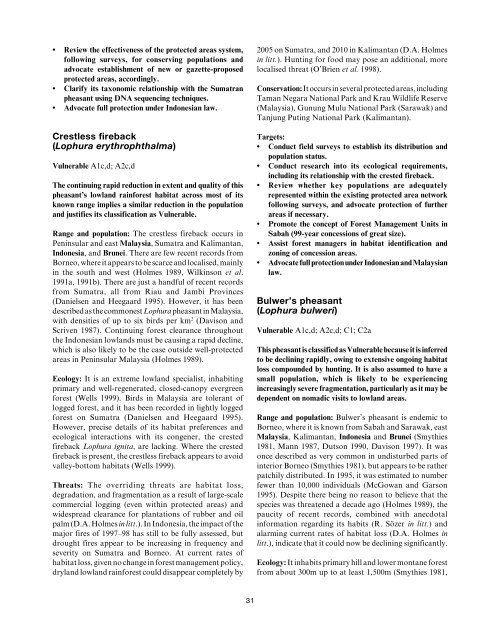Pheasants: Status Survey and Conservation Action Plan ... - IUCN
Pheasants: Status Survey and Conservation Action Plan ... - IUCN
Pheasants: Status Survey and Conservation Action Plan ... - IUCN
You also want an ePaper? Increase the reach of your titles
YUMPU automatically turns print PDFs into web optimized ePapers that Google loves.
• Review the effectiveness of the protected areas system,<br />
following surveys, for conserving populations <strong>and</strong><br />
advocate establishment of new or gazette-proposed<br />
protected areas, accordingly.<br />
• Clarify its taxonomic relationship with the Sumatran<br />
pheasant using DNA sequencing techniques.<br />
• Advocate full protection under Indonesian law.<br />
Crestless fireback<br />
(Lophura erythrophthalma)<br />
Vulnerable A1c,d; A2c,d<br />
The continuing rapid reduction in extent <strong>and</strong> quality of this<br />
pheasant’s lowl<strong>and</strong> rainforest habitat across most of its<br />
known range implies a similar reduction in the population<br />
<strong>and</strong> justifies its classification as Vulnerable.<br />
Range <strong>and</strong> population: The crestless fireback occurs in<br />
Peninsular <strong>and</strong> east Malaysia, Sumatra <strong>and</strong> Kalimantan,<br />
Indonesia, <strong>and</strong> Brunei. There are few recent records from<br />
Borneo, where it appears to be scarce <strong>and</strong> localised, mainly<br />
in the south <strong>and</strong> west (Holmes 1989, Wilkinson et al.<br />
1991a, 1991b). There are just a h<strong>and</strong>ful of recent records<br />
from Sumatra, all from Riau <strong>and</strong> Jambi Provinces<br />
(Danielsen <strong>and</strong> Heegaard 1995). However, it has been<br />
described as the commonest Lophura pheasant in Malaysia,<br />
with densities of up to six birds per km 2 (Davison <strong>and</strong><br />
Scriven 1987). Continuing forest clearance throughout<br />
the Indonesian lowl<strong>and</strong>s must be causing a rapid decline,<br />
which is also likely to be the case outside well-protected<br />
areas in Peninsular Malaysia (Holmes 1989).<br />
Ecology: It is an extreme lowl<strong>and</strong> specialist, inhabiting<br />
primary <strong>and</strong> well-regenerated, closed-canopy evergreen<br />
forest (Wells 1999). Birds in Malaysia are tolerant of<br />
logged forest, <strong>and</strong> it has been recorded in lightly logged<br />
forest on Sumatra (Danielsen <strong>and</strong> Heegaard 1995).<br />
However, precise details of its habitat preferences <strong>and</strong><br />
ecological interactions with its congener, the crested<br />
fireback Lophura ignita, are lacking. Where the crested<br />
fireback is present, the crestless fireback appears to avoid<br />
valley-bottom habitats (Wells 1999).<br />
Threats: The overriding threats are habitat loss,<br />
degradation, <strong>and</strong> fragmentation as a result of large-scale<br />
commercial logging (even within protected areas) <strong>and</strong><br />
widespread clearance for plantations of rubber <strong>and</strong> oil<br />
palm (D.A. Holmes in litt.). In Indonesia, the impact of the<br />
major fires of 1997–98 has still to be fully assessed, but<br />
drought fires appear to be increasing in frequency <strong>and</strong><br />
severity on Sumatra <strong>and</strong> Borneo. At current rates of<br />
habitat loss, given no change in forest management policy,<br />
dryl<strong>and</strong> lowl<strong>and</strong> rainforest could disappear completely by<br />
2005 on Sumatra, <strong>and</strong> 2010 in Kalimantan (D.A. Holmes<br />
in litt.). Hunting for food may pose an additional, more<br />
localised threat (O’Brien et al. 1998).<br />
<strong>Conservation</strong>: It occurs in several protected areas, including<br />
Taman Negara National Park <strong>and</strong> Krau Wildlife Reserve<br />
(Malaysia), Gunung Mulu National Park (Sarawak) <strong>and</strong><br />
Tanjung Puting National Park (Kalimantan).<br />
Targets:<br />
• Conduct field surveys to establish its distribution <strong>and</strong><br />
population status.<br />
• Conduct research into its ecological requirements,<br />
including its relationship with the crested fireback.<br />
• Review whether key populations are adequately<br />
represented within the existing protected area network<br />
following surveys, <strong>and</strong> advocate protection of further<br />
areas if necessary.<br />
• Promote the concept of Forest Management Units in<br />
Sabah (99-year concessions of great size).<br />
• Assist forest managers in habitat identification <strong>and</strong><br />
zoning of concession areas.<br />
• Advocate full protection under Indonesian <strong>and</strong> Malaysian<br />
law.<br />
Bulwer’s pheasant<br />
(Lophura bulweri)<br />
Vulnerable A1c,d; A2c,d; C1; C2a<br />
This pheasant is classified as Vulnerable because it is inferred<br />
to be declining rapidly, owing to extensive ongoing habitat<br />
loss compounded by hunting. It is also assumed to have a<br />
small population, which is likely to be experiencing<br />
increasingly severe fragmentation, particularly as it may be<br />
dependent on nomadic visits to lowl<strong>and</strong> areas.<br />
Range <strong>and</strong> population: Bulwer’s pheasant is endemic to<br />
Borneo, where it is known from Sabah <strong>and</strong> Sarawak, east<br />
Malaysia, Kalimantan, Indonesia <strong>and</strong> Brunei (Smythies<br />
1981, Mann 1987, Dutson 1990, Davison 1997). It was<br />
once described as very common in undisturbed parts of<br />
interior Borneo (Smythies 1981), but appears to be rather<br />
patchily distributed. In 1995, it was estimated to number<br />
fewer than 10,000 individuals (McGowan <strong>and</strong> Garson<br />
1995). Despite there being no reason to believe that the<br />
species was threatened a decade ago (Holmes 1989), the<br />
paucity of recent records, combined with anecdotal<br />
information regarding its habits (R. Sözer in litt.) <strong>and</strong><br />
alarming current rates of habitat loss (D.A. Holmes in<br />
litt.), indicate that it could now be declining significantly.<br />
Ecology: It inhabits primary hill <strong>and</strong> lower montane forest<br />
from about 300m up to at least 1,500m (Smythies 1981,<br />
31
















